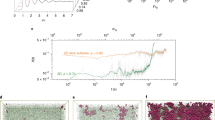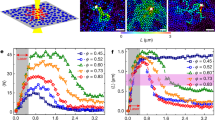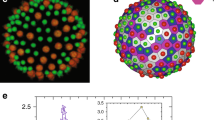Abstract
Glass formation in colloidal suspensions has many of the hallmarks of glass formation in molecular materials1,2,3,4,5. For hard-sphere colloids, which interact only as a result of excluded volume, phase behaviour is controlled by volume fraction, φ; an increase in φ drives the system towards its glassy state, analogously to a decrease in temperature, T, in molecular systems. When φ increases above φ* ≈ 0.53, the viscosity starts to increase significantly, and the system eventually moves out of equilibrium at the glass transition, φg ≈ 0.58, where particle crowding greatly restricts structural relaxation1,2,3,4. The large particle size makes it possible to study both structure and dynamics with light scattering1 and imaging3,4; colloidal suspensions have therefore provided considerable insight into the glass transition. However, hard-sphere colloidal suspensions do not exhibit the same diversity of behaviour as molecular glasses. This is highlighted by the wide variation in behaviour observed for the viscosity or structural relaxation time, τα , when the glassy state is approached in supercooled molecular liquids5. This variation is characterized by the unifying concept of fragility5, which has spurred the search for a ‘universal’ description of dynamic arrest in glass-forming liquids. For ‘fragile’ liquids, τα is highly sensitive to changes in T, whereas non-fragile, or ‘strong’, liquids show a much lower T sensitivity. In contrast, hard-sphere colloidal suspensions are restricted to fragile behaviour, as determined by their φ dependence1,6, ultimately limiting their utility in the study of the glass transition. Here we show that deformable colloidal particles, when studied through their concentration dependence at fixed temperature, do exhibit the same variation in fragility as that observed in the T dependence of molecular liquids at fixed volume. Their fragility is dictated by elastic properties on the scale of individual colloidal particles. Furthermore, we find an equivalent effect in molecular systems, where elasticity directly reflects fragility. Colloidal suspensions may thus provide new insight into glass formation in molecular systems.
This is a preview of subscription content, access via your institution
Access options
Subscribe to this journal
Receive 51 print issues and online access
$199.00 per year
only $3.90 per issue
Buy this article
- Purchase on Springer Link
- Instant access to full article PDF
Prices may be subject to local taxes which are calculated during checkout



Similar content being viewed by others
References
van Megen, W. & Pusey, P. N. Dynamic light-scattering study of the glass transition in a colloidal suspension. Phys. Rev. A 43, 5429–5441 (1991)
Mason, T. G. & Weitz, D. A. Linear viscoelasticity of colloidal hard sphere suspensions near the glass transition. Phys. Rev. Lett. 75, 2770–2773 (1995)
Kegel, W. K. & van Blaaderen, A. Direct observation of dynamical heterogeneities in colloidal hard-sphere suspensions. Science 287, 290–293 (2000)
Weeks, E. R., Crocker, J. C., Levitt, A. C., Schofield, A. & Weitz, D. A. Three-dimensional direct imaging of structural relaxation near the colloidal glass transition. Science 287, 627–631 (2000)
Angell, C. A., Ngai, K. L., McKenna, G. B., McMillan, P. F. & Martin, S. W. Relaxation in glassforming liquids and amorphous solids. J. Appl. Phys. 88, 3113–3157 (2000)
Cheng, Z., Zhu, J., Chaikin, P. M., Phan, S.-E. & Russel, W. B. Nature of the divergence in low shear viscosity of colloidal hard-sphere dispersions. Phys. Rev. E 65, 041405 (2002)
Stieger, M., Pedersen, J. S., Lindner, P. & Richtering, W. Are thermoresponsive microgels a model system for concentrated colloidal suspensions? A rheology and small-angle neutron scattering study. Langmuir 20, 7283–7292 (2004)
Bartsch, E., Antonietti, M., Schupp, W. & Sillescu, H. The glass transition dynamics of polymer micronetwork colloids. A mode coupling analysis. J. Chem. Phys. 97, 3950–3963 (1992)
Herbst, C. A., Cook, R. L. & King, H. E. Density-mediated transport and the glass transition: high pressure viscosity measurements in the diamond anvil cell. J. Non-Cryst. Solids 172–174, 265–271 (1994)
Tobolsky, A. V., Powell, R. E. & Eyring, H. in Frontiers in Chemistry Vol. 1 (eds Burk, R. E. & Grummit, O.) 125–190 (Interscience, 1943)
Nemilov, S. V. Thermodynamic and Kinetic Aspects of the Vitreous State (CRC Press, 1995)
Scopigno, T., Ruocco, G., Sette, F. & Monaco, G. Is the fragility of a liquid embedded in the properties of its glass? Science 302, 849–852 (2003)
Novikov, V. N. & Sokolov, A. P. Poisson’s ratio and the fragility of glass-forming liquids. Nature 431, 961–963 (2004)
Novikov, V. N., Ding, Y. & Sokolov, A. P. Correlation of fragility of supercooled liquids with elastic properties of glasses. Phys. Rev. E 71, 061501 (2005)
Dyre, J. C. The glass transition and elastic models of glass-forming liquids. Rev. Mod. Phys. 78, 953–972 (2006)
Sastry, S., Debenedetti, P. G. & Stillinger, F. H. Signatures of distinct dynamical regimes in the energy landscape of a glass-forming liquid. Nature 393, 554–557 (1998)
Ito, K., Moynihan, C. T. & Angell, C. A. Thermodynamic determination of fragility in liquids and a fragile-to-strong liquid transition in water. Nature 398, 492–495 (1999)
Martinez, L.-M. & Angell, C. A. A thermodynamic connection to the fragility of glass-forming liquids. Nature 410, 663–667 (2001)
Brumer, Y. & Reichman, D. R. Mean-field theory, mode-coupling theory, and the onset temperature in supercooled liquids. Phys. Rev. E 69, 041202 (2004)
Wyart, M. On the rigidity of amorphous solids. Ann. Phys. Fr. 30, 1–96 (2005)
Shintani, H. & Tanaka, H. Frustration on the way to crystallization in glass. Nature Mater. 7, 870–877 (2008)
Roovers, J. Concentration dependence of the relative viscosity of star polymers. Macromolecules 27, 5359–5364 (1994)
Buitenhuis, J. & Förster, S. Block copolymer micelles: viscoelasticity and interaction potential of soft spheres. J. Chem. Phys. 107, 262–272 (1997)
Xia, X. & Hu, Z. Synthesis and light scattering study of microgels with interpenetrating polymer networks. Langmuir 20, 2094–2098 (2004)
Shikata, T. & Pearson, D. S. Viscoelastic behaviour of concentrated spherical suspensions. J. Rheol. 38, 601–616 (1994)
Kumar, S., Szamel, G. & Douglas, J. F. Nature of the breakdown in the Stokes-Einstein relationship in a hard sphere fluid. J. Chem. Phys. 124, 214501 (2006)
Wang, C. H., Zhu, X. R. & Shen, J. C. Angular and temperature dependence of depolarized and polarized Rayleigh-Brillouin spectra of a supercooled liquid: o-terphenyl. Mol. Phys. 62, 749–764 (1987)
Enright, G. D. & Stoicheff, B. P. Light scattering from shear modes in liquid salol. J. Chem. Phys. 64, 3658–3665 (1976)
Scarponi, F., Comez, L., Fioretto, D. & Palmieri, L. Brillouin light scattering from transverse and longitudinal acoustic waves in glycerol. Phys. Rev. B 70, 054203 (2004)
Polian, A., Vo-Thanh, D. & Richet, P. Elastic properties of a-SiO2 up to 2300 K from Brillouin scattering measurements. Europhys. Lett. 57, 375–381 (2002)
Acknowledgements
We are grateful to J. Zhou for technical assistance, to J. Bergenholtz for complimentary use of his light-scattering equipment and to J.-W. Kim for discussions. This work was supported by the US National Science Foundation and Harvard University’s Materials Research Science and Engineering Center; by the Hans Werthén Foundation, the Wenner-Gren Foundation, the Knut and Alice Wallenberg Foundation and the Royal Society of Arts and Sciences in Göteborg (J.M.); by the Ministerio de Ciencia e Innovación and the University of Almeria (A.F.-N.); and by KAKENHI (K.M.).
Author Contributions J.M. and H.M.W. designed the study, performed the experiments, analysed and interpreted the data and wrote the manuscript; A.F.-N. designed the study, interpreted the data and wrote the manuscript; Z.H. designed the samples and contributed to the writing of the manuscript; K.M., D.R.R. and D.A.W. each contributed to data interpretation and the writing of the manuscript.
Author information
Authors and Affiliations
Corresponding author
Supplementary information
Supplementary Information
This file contains Supplementary Figures 1- 4 with Legends, Supplementary Methods and Supplementary References. (PDF 505 kb)
Rights and permissions
About this article
Cite this article
Mattsson, J., Wyss, H., Fernandez-Nieves, A. et al. Soft colloids make strong glasses. Nature 462, 83–86 (2009). https://doi.org/10.1038/nature08457
Received:
Accepted:
Issue Date:
DOI: https://doi.org/10.1038/nature08457
This article is cited by
-
Analysis of the glass effect and Trommsdorff effect during bulk polymerization of methyl methacrylate, ethyl methacrylate, and butyl methacrylate
Polymer Journal (2023)
-
Revealing the relationship between liquid fragility and medium-range order in silicate glasses
Nature Communications (2023)
-
Polymerization-induced vitrification, apparent phase separation, and reaction acceleration during bulk polymerization
Polymer Journal (2023)
-
Large amplitude oscillatory shear studies on dense PNIPAM microgel colloidal glasses
Colloid and Polymer Science (2023)
-
Influence of the interatomic repulsive hardness on the microstructure and dynamics of CuZr metallic glasses
Journal of Molecular Modeling (2022)
Comments
By submitting a comment you agree to abide by our Terms and Community Guidelines. If you find something abusive or that does not comply with our terms or guidelines please flag it as inappropriate.



